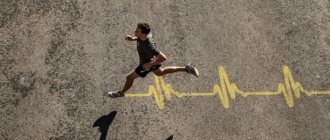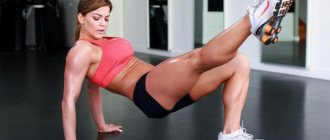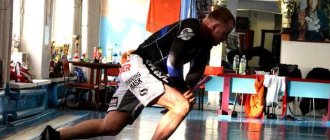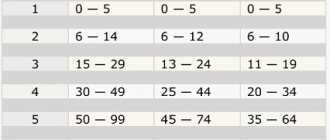Just because you can run 100 meters in 15 seconds doesn't mean you can run a half marathon that fast.
This fact seems obvious, but many beginners do not take it into account when preparing for their first competition. They recalculate their speed, which they managed to achieve in training, for long distances. At competitions, expectations are not met, motivation and self-confidence drop.
Why is this happening? In order to cover a certain distance at the required pace, it is necessary to develop endurance. What kind of training to increase running endurance depends on what kind of result you want to get.
Let's look at the main characteristics, classification and each individual type of endurance training.
What is endurance running
The concept of endurance running is often found in publications devoted to sports, physical education, weight loss and a healthy lifestyle. But it is used there in different meanings. Let's look at the main ones.
- In its most general sense, endurance running is understood as the opposite of speed running over short distances. For the latter, the so-called explosive strength and fast strength are important. To put it simply, in this case, the definition of endurance running includes any running except sprinting.
- In a narrower sense, this term refers to training that requires a person to have a serious supply of endurance. These are long-distance races (for example, the now popular marathon and half-marathon) or long time periods (more than 40 minutes). As a rule, they assume moving at the same pace throughout the entire distance.
- The third value is running training programs to develop endurance. They usually combine sections of the route that the athlete passes in different modes: easy running, jogging, with acceleration. Also, sometimes the features of the terrain are taken into account (running uphill, over rough terrain, etc.), and special running exercises are added (running with hip tightening, shin overlapping, with jumping, etc.).
In our article we will focus on the third option.
Speed running technique
In speed running, not only the legs and the smooth push of the foot from the ground are important. An equally significant role is played by the positioning of the body, arms and even the head. By moving our hands we set our pace. Under no circumstances should they be pressed against the body. The arms move freely in tandem with the legs, bent at a right angle.
The movement is carried out with opposite hands and feet, so that the abdominal muscles do not contract and do not pinch the internal organs. The shoulder girdle should be relaxed. No need to look at your feet. Just straight ahead.
Another mistake is swinging the body after the arms. Thus, the athlete loses a lot of energy and gets tired quickly. Therefore, the body needs to be slightly tilted forward by 5-7 degrees and kept perpendicular to the ground or floor.
Foot placement is of great importance. It is necessary to ensure that it comes into contact with the surface as little as possible. The stride width should also be optimal for you, ensuring a smooth run.
It is best to practice the technique with a trainer. Since everyone has their own individual characteristics, which are best adjusted to avoid injury.
What is endurance
Endurance is a person’s ability to perform any action, work, or exercise over a long period of time while maintaining approximately the same level of efficiency.
There are general and special endurance. The first of them reflects the performance of the body as a whole, when performing a random exercise or a set of exercises. It affects tissue metabolism and is an important indicator of human health.
Special endurance reflects a person’s ability to perform a specific action for a long time. So, for example, someone can run for a long time without slowing down, but quickly gets tired if they are required to lift heavy things up the stairs to a high floor. However, as a rule, it is easier for a person with high endurance of one type to develop it in relation to other operations.
Specifically, running endurance refers to a complex of factors that develop a person’s ability to maintain a running pace for as long as possible while maintaining the correct technique of movement and breathing.
At the physiological level, endurance training has the following effects on the development of body systems and organs:
- The heart muscle is strengthened. The stroke volume of the heart increases (the amount of blood that the right and left ventricles are able to pump in one compression). Arterial and venous pressure stabilizes.
- The total blood volume and hemoglobin mass increases.
- The density of the capillary network increases.
- The amount of myoglobin increases, a substance that ensures muscle tissue absorbs oxygen from the blood.
- The muscles “learn” to use oxygen and energy more economically.
In turn, an increase in any of these indicators, caused by other third-party factors, leads to increased endurance.
What is endurance and its characteristics?
Endurance is the ability to withstand fatigue, that is, to perform some work with the same effectiveness. It is measured by the amount of time at which a given intensity is maintained.
Developing endurance is important not only in sports, but also in everyday life and profession - it is a tool not only for health, but also for success in general.
Important! A resilient person is able to stay awake for 24 hours or more when performing physical activity.
Why do you need endurance training?
There are many reasons to turn to specialized endurance training. For example, if you started training with the goal of losing weight, but you get tired too quickly and you can’t do aerobic exercise for a long time (whether it’s running, an exercise bike or an elliptical). In this case, it is worth turning to endurance running programs that are specifically designed to increase your ability to maintain prolonged aerobic activity.
This type of training is also recommended for those who return to sports activities after a long break. It is also suitable for training after injuries to maintain general physical fitness, when exercises for targeted development of certain muscle groups or practicing complex actions are not available.
Athletes turn to endurance training at a certain stage of preparation for competition. For amateurs, such exercises will provide an invaluable service in the overall strengthening of the body.
Types of endurance and methods of its development in running
Main types of endurance:
- General or aerobic - the ability to perform intense moderate physical work over a long period of time.
- Special - endurance in a specific sport, maintained for a long time at a given intensity. Most often this is an anaerobic load.
Special endurance classification:
- Speed is a period of time during which it is possible to maintain the speed and tempo of certain movements in a certain mode.
- Strength - the ability to engage in strength work (muscular ability) for a long time with sufficient efficiency. Usually we are talking about heavy exercises without technical violations. With this quality, the muscles are capable of activity in a minimum of time.
- Coordination - manifests itself with repeated repetition of technically complex or tactical actions. This refers to sports games or gymnastics.
General requirements for running exercises to develop endurance
In order not to repeat ourselves every time, let’s make a reservation in advance: the general requirement for each program is a preliminary warm-up. It should include not only light retracting running, but also exercises on the spot. It is necessary to work on the cervical and hip regions, arms and legs. During the warm-up, you should perform rotation, swing/snatch, and stretching exercises. They are not considered mandatory, but special running exercises for short distances up to 30 meters are useful. These include:
- running with high hip lifts;
- running with shin sprains;
- running with straight legs;
- side steps;
- running sideways with legs crossed;
- jumping (multi-jump);
- walking with lunges;
- running with squats;
- tempo jumps on one leg;
- other exercises.
The composition of special running exercises before each workout can be changed depending on your own preferences.
You should not start a long-distance race immediately at a fast pace. While an experienced runner can still afford this, a beginner runs the risk of stopping halfway, minimizing the benefits. Remember: at first, the duration of the run is more important to you, not its speed.
Watch your running technique - endurance exercise puts much more stress on your joints than high-speed sprint races and even some distance races. Here are the main nuances that you should pay attention to:
- Do not bend your body, keep it straight, do not slouch. This is not only harmful to posture, but also leads to excessive energy consumption.
- Bring your swing leg forward as far as possible, but try to lower it onto your toes to absorb the shock.
- Move and breathe rhythmically, with one inhalation per two steps and one exhalation per two steps.
- Do not try to work too vigorously with your hands, this will lead to unnecessary expenditure of energy and oxygen.
There is no need to start right off the bat. Start with stretching workouts. Your first endurance runs should be at least 20 minutes long. But the pace should be chosen so that you can talk throughout the entire distance without severe shortness of breath.
Now let's look at the main types of endurance running programs.
Proper nutrition
Your diet should consist of 55 - 65% carbohydrates. This doesn't mean you have to eat a mountain of pasta at every meal, but make sure your daily intake is enough to support your training and recovery.
2-3 hours before prolonged or intense exercise, you should eat a carbohydrate-rich meal to replenish your energy reserves. If you find yourself feeling very tired, often in a bad mood, or unable to complete your planned runs, try increasing your carbohydrate intake. Try to eat complex carbohydrates (grains, brown rice, potatoes, pasta, oatmeal) rather than refined or sugary foods, which will spike your blood sugar (which is always followed by a spike).
What types of running develop endurance?
Now let's figure out how to increase running endurance. As a rule, in order to achieve the designated goal, it is recommended to turn to the following types of training:
- interval training;
- pyramid type interval training;
- running with weights;
- running uphill;
- alternative types of endurance running training;
- non-specific (related) exercises.
Endurance running programs are built very individually, so we will focus on a comprehensive description of the techniques themselves. But first - general requirements that are valid for each of them.
Developing muscle strength and endurance
Increasing muscle endurance requires following certain rules:
- When performing any load, the muscles are not pinched - that is, not tense.
- Compliance with the drinking regime - water is a regulator of energy distribution in the body.
- Balanced nutrition - the diet must contain proteins, fats, carbohydrates and all necessary mineral compounds in the required quantities.
- Interval training is the most effective way to increase endurance.
At home you can do squats, push-ups, pull-ups, jumping over a bench, etc. The main principle here is a gradual increase in load (the number of approaches increases) and a feasible pace. To do this, increase the number of repetitions of one exercise. Olympic records will only do harm. It is better to exercise every other day so that the body has time to recover.
Endurance interval running
Interval training involves running with periodic changes in pace in accordance with the selected program. They actively use the respiratory and circulatory systems and help burn calories.
Beginners often turn to the option of interval running followed by walking. In the first stages, periods of walking or light running will prevail over acceleration. So, it is recommended to use the following scheme: 1 minute of running at a high pace, followed by 2 minutes of walking or jogging. The cycle is repeated 6-7 times.
Gradually, fast running intervals should lengthen. The most common option is in which the runner maintains a fast pace for 2 minutes, after which he walks for 30 seconds. If you exercise on a treadmill or in a stadium with convenient markings, you can focus not on time, but on distance. For example, on a circle 200 meters long, two straights and a bend (about 160 meters) should be run at speed, and one bend (about 40 meters) should be walked.
How to develop running speed?
It is believed that running speed depends on genetics. Of course, we cannot radically influence the speed of processes occurring in our central nervous system. But we have the power to activate them and thus develop the speed potential of our muscles.
Speed is greatly influenced by the psychosomatic factor. If a person is constantly tense and stressed and does not know how to relax, speed exercises will be very difficult for him. It is very important to learn to move like a cat while in a relaxed state. Otherwise, there is a high risk of injury.
The second component of fast running is step length and frequency. Therefore, emphasis in speed training should be placed, among other things, on technique.
Pyramid-type endurance interval training
As you can see, in both proposed schemes, the load from cycle to cycle within one workout remains the same. More advanced athletes turn to the so-called pyramid scheme. It requires good physical fitness, but its effectiveness is significantly superior to classic “uniform” interval training.
A pyramid-type exercise is structured in such a way that the duration of acceleration and rest gradually increases from the beginning of the workout to the middle, and then “mirror” decreases. To ensure accurate execution of the program, it is recommended to use a stopwatch.
An example of such a scheme:
Warm up: 10-15 minutes.
Cycle 1: 30 seconds of intense running, 1 minute of jogging.
Cycle 2: 45 seconds of intense running, 1 minute 15 seconds of jogging.
Cycle 3: 1 minute of intense running, 1 minute 30 seconds of jogging.
Cycle 4: 1 minute 30 seconds of intense running, 2 minutes of jogging.
Cycle 5: 1 minute of intense running, 1 minute 30 seconds of jogging.
Cycle 6: 45 seconds of intense running, 1 minute 15 seconds of jogging.
Cycle 7: 30 seconds of intense running, 1 minute of jogging.
Cool down: 20 minutes of easy running followed by a walk.
Please note that the diagram shown is for illustration only. Specific intervals should be selected and increased individually to avoid overload. Let us remind you that pyramid-type training is very energy-intensive.
What a training program might look like
Running endurance training (abbreviated):
- Week 1. During this week, try to increase the duration of your run from 10 to 20 minutes. Exercise every day. This is achieved by adding 1.5-2 minutes daily. However, Sunday is a day off.
- Week 2. During this week, jogging time increases to 25 minutes, but the rate of increase in loads is gradually reduced. At the end of 2 weeks, 25 minutes ceases to be problematic. Sunday is a day off.
- Week 3: Goal: Get to 30 minutes a day. Sunday is rest.
Running with weights to develop endurance
As with the pyramid, weighted running is an option for advanced runners. It makes sense to use it if you are able to cover a distance of 10 km at an average pace. The additional weight provides the body with an unusual amount of muscle effort, creating a stressful load on the muscles. In addition to endurance, this also allows you to develop fast and explosive strength, so this type of exercise is used not only by runners, but also by football players, basketball players, cyclists, jumpers and representatives of other sports disciplines in which these indicators are important.
As weighting, it is recommended to use special cuffs with weights that are worn on the shins and forearms. However, in the absence of such, many use backpacks filled with some heavy material, such as sand. If you choose this option, make sure that the backpack fits comfortably on your back: adjust the length of the straps, try to see if the load rests on your back and does not rub it.
When using weights, experience in running is needed not only from the point of view of the starting endurance reserve. You need to be able to listen to your body. Additional weight creates extra stress on the spine and joints, which can cause injuries. Therefore, if you feel that you lack sports experience, it is better to turn to the next type of endurance running.
Suitable for everyone
The running training system, which I will discuss below, is universal. It is suitable for both a completely untrained overweight person who has decided to get his body in order, and an advanced athlete who has been training with weights for years, but ignores running for various reasons.
For example, your knees hurt, you have shortness of breath, your muscles “burn” (do not burn). I can safely classify myself as the latter, and I have previously approached the issue of running more than once, but only now have I found truly effective methods of using it.
About ten years ago I conducted an experiment - I wanted to run 10 km at a time. I achieved results, but it was difficult and took more than three months. The hope of eating tasty treats while losing fat through long running did not materialize. And I ran 10 km with difficulty, which is called “I can’t”. Then I more or less accustomed myself to running (I used to hate it at all), but these are flowers compared to the results of a reasonable approach to training.
Uphill endurance running
Running uphill not only develops endurance. Its specificity is such that it uses additional muscle groups, which, although they are used during normal jogging, receive significantly less load.
Although this option is less traumatic than running with weights, it is also necessary to follow a number of safety rules:
- when running uphill, do not look at your feet, as this will shift the center of gravity and disrupt the geometry of your body and running technique;
- You should also not fix your eyes on the top of the route, this is not only inconvenient, but also psychologically difficult, so ideally you should direct your eyes to a point on the route 5–10 meters in front of you;
- do not allow the lower back to bend; the torso should be kept straight, while maintaining its general slight tilt forward.
Don't forget that endurance training should be long enough, so don't set yourself the goal of leaving your last strength on the first climb.
A slope of 5–15% is best suited for such training, that is, an increase of 5–15 meters for every 100 meters of distance. If now, while you are reading these lines, it seems to you that this is almost a horizontal surface and you don’t feel much difference with flat terrain, then believe me, the very first lesson will change your ideas.
Regarding the training scheme, we must again say that it is selected individually. As a guide, we can offer the following option:
Warm up: 10-15 minutes of easy running on flat ground.
Running cycle:
- Run uphill at a speed close to maximum - 200 meters.
- The descent from the mountain is easy by running - 200 meters.
- Run uphill at 70-80% of maximum speed - 200-300 meters.
- The descent from the mountain is easy by running - 200–300 meters.
Repeat the cycle as many times as necessary.
Cool down: 20–30 minutes of easy running on level ground.
At the initial stage, two cycles (that is, four lifts) will be enough. In the future, you can increase the number of cycles to four to six.
If you exercise on a treadmill, you can achieve the desired effect by changing the inclination angle of the belt. This function is provided in many modern models of simulators. But we should not forget that the speed on a treadmill is most often limited to 12–15 km/h, so it is preferable to do uphill endurance running outdoors and use the natural uneven terrain for it.
On a separate note, you can also include sections of hilly or rugged terrain into your regular running route. Running on hills, in shallow water or sand will diversify the load on the muscles in unusual conditions. If you are ready to maintain your running pace in such conditions, then you are on the right track!
How to develop endurance?
It makes sense that the longer you run, the more endurance you develop. Therefore, the easiest way is to gradually increase the distance, lengthening it by 10% each subsequent workout. This will strengthen the cardiovascular system and develop the respiratory system. In addition, it is very important that in this mode our body begins to learn to use fats as “fuel”. This way, you can work up to a 60-minute run and then make the program more challenging by choosing hilly terrain or increasing the incline on the treadmill. The pace needs to be chosen so that you can talk while running and not get out of breath.
Another exercise that increases endurance is overcoming, for example, 500-1000 meters in a certain time that you can do. The “trick” is to run your standard not just once, but from three to eight. For example, the goal is 500 meters in 3.5 minutes. We try to do this several times in a row. But no more than 10 times in one workout.
It is quite possible that it will not work out right away. There is no need to be upset. Just train regularly, and the results will not be long in coming. By the way, these two types of running exercises can be alternated.
You can include jumping in your training program, of course, if there are no problems with the musculoskeletal system. Plyometrics immediately develops speed, speed and power. One of the safest exercises in her arsenal is running with high knees for 6-8 approaches over distances of 15-20 meters. Various jumps on one and two legs, jumping on the steps of a ladder, jumping out of a squat will be useful.
Plyometric exercises are not recommended to be performed on asphalt, so as not to injure the joints. Choose more gentle types of surfaces - dirt, special coating in stadiums, playgrounds, or train in the gym.
Sharp acceleration in the last quarter of the training distance increases endurance very effectively. At first, be prepared for muscle soreness. It will pass after your body adapts to the stress.
Endurance running according to the Bart Jasso method
There are several more methodological developments for increasing endurance through running. They are not as common, and estimates of their effectiveness vary from one source to another. However, it would be unfair to remain silent about them. Let's start with the so-called Bart Jasso method.
Bart Yasso is a famous American athlete, marathon runner, who developed his own concept of training for long-distance races. His idea is to run several 800-meter intervals during training. At the same time, you need to move at such a pace that the speed is the same on each segment. You need to start with 4-5 approaches. Then you should add 1 interval every week until their number reaches 10.
Note that in the final stages, 10 intervals of 800 meters at the same pace is a difficult test even for experienced athletes.
It is believed that if you take the time shown by a runner at an 800-meter distance (at the stage of 10 repetitions) and convert minutes into hours, and seconds into minutes, you will get an approximate result that he would demonstrate in a marathon race (42, 2 km). This manipulation of numbers is called the “Jasso test.”
There is no scientific basis for this technique; it is only the fruit of the athlete’s experience and observations. But in fairness, it should be noted that in most cases the Yasso test is confirmed in practice.
A universal but insidious discipline
On the one hand, everything is so. On the other hand, running power is in many cases overestimated or not taken into account at all.
Thus, running increases the effectiveness of strength training - it increases working weights and the intensity of training. It is an important aid in getting rid of excess fat. This is if everything is done correctly, which we will discuss below. There are also opposite cases.
For example, a person decided to lose weight - it doesn’t matter whether it’s a guy or a girl - and let’s run furiously. After all, he had heard out of the corner of his ear that running allows you to lose excess weight. The comrade sheds seven sweats, red as a lobster, his heart jumps out of his chest, his legs give way, there is not enough air, but he continues to move his legs that have become weak - he needs to run these 3-4 km.
I ran for a month three times a week, suffered a lot, got on the scales, but there was no result. The reflection in the mirror hasn't changed much either. This is the best case scenario. At worst, he began to look bad, his health was also not great, his knees hurt, he became emaciated (there are fewer muscles, the fat has not gone anywhere), and the pitiful 2-3 kg lost out of a hundredweight of total body weight are not at all pleasing.
The fact is that you need to run correctly and build the training process wisely, while not forgetting about nutrition and a number of other factors. Let's talk about everything in more detail.
Endurance running using the Bill Pierce method
Bill Pierce is also a famous marathon runner whose sporting experience spans more than a quarter of a century. The idea behind his method is to alternate training days with light and heavy loads.
An example of a training scheme using the Pierce method looks like this:
First training day: 12 intervals of 400 meters.
Second training day: 4 kilometers at high speed.
Third training day: 10 kilometers at a slow speed.
These three workouts represent a weekly cycle. On other days, you can do strength exercises or just relax. Pierce himself often devotes them to table tennis.
The athlete confirms the effectiveness of the method with his example. Even having crossed the 50-year-old mark, he continues to participate in marathon races and demonstrate more than decent results.
What is endurance needed for?
Endurance is the ability of the human body to withstand active physical activity for a long time without losing performance. Why and who needs to develop endurance:
- Overweight people . Do you want to lose weight? You need to run and move more. If your endurance is low, you will not be able to withstand a long, albeit not very intense, load. This means you will burn fewer calories. Therefore, it is necessary to increase this indicator
- For athletes . If you are a long-distance runner, it is necessary to develop and maintain high levels of endurance. Otherwise, you won’t be able to beat your opponents in competitions. Good endurance helps you not get tired and concentrate on other important points during the marathon - keeping an eye on your opponents, getting around them, controlling your speed.
- People involved in active sports and recreation are busy with hard work. These are rock climbers, mountain climbers, athletes, cyclists, dancers, industrial climbers and others. During professional activities or favorite activities, their body experiences a lot of stress . Well-developed endurance will help you withstand it.
A person with a sedentary lifestyle and without much physical activity does not need running endurance exercises. To maintain good health, regular half-hour daily jogging is enough.
It is important
If you are an amateur athlete, there is no particular need to increase endurance and speed. This is more necessary for professionals who participate in competitions, because the development of speed endurance in running is very important for them. People who simply run “for health” do not necessarily need to improve their sports skills.
Endurance running using the Warren Finke method
American trainer Warren Finke recommends running at 75–80% of maximum speed to develop endurance. To calculate the latter, you need to do a test run of 1000 meters.
Let's say you showed a time of 4 minutes. Multiply the result by 1.25 and get 5 minutes. This corresponds to an average speed of 12 km/h, which is the pace you should run during training.
It is recommended to record your results in a diary or mobile application.
This method is believed to be easy enough for beginners to learn.
Endurance running using the Patrick Noble method
Patrick Noble is not only an athlete, but also a professional military man. He proposed his own method of increasing endurance, which consists of including long tempo training in the weekly training cycle.
This means that in the first week you should go for a five-minute run. Each subsequent week you should add 5 minutes. The second week you'll do a 10-minute run, the third week a 15-minute run, and so on. In less than 3 months you should reach the hour mark.
Please note that there should be other training in the weekly cycle, but after each long tempo run you need to give the body two days of complete rest.
Endurance running using the Dina Drossin method (plyometrics)
Dina Drossin is one of the most successful female runners in the United States. The technique she proposed was called plyometrics. The idea of the method is to develop endurance by including a set of sharp non-standard movements in running training.
For example, you can make jumps every ten to twenty meters. Or switch to a very fast short (mincing) step. You can also refer to jumps on one leg, multi-jumps, etc.
If you decide to choose this method, we recommend paying attention to comfortable shoes with good shock-absorbing soles, as a lot of stress will be placed on the ankle.
Top 10 popular exercises for developing speed performance
- Running in a straight line. The exercise begins at a slow pace, then the speed increases every 50 meters. Perform 5-6 approaches. The number of segments is selected based on the runner’s level of fitness.
- The same running in a straight line, but with the body tilted about 5 degrees to the surface. About 10 repetitions.
- Running from a low start. We overcome segments of 50 meters. You need to complete 5 repetitions in total.
- Jumping lunges on toes. Important: alternate legs, do not touch the ground with your heels. Running in place with jumping up. Your heels should touch your buttocks.
- Jumping from one leg to the other while moving forward.
- Jumping with alternating legs from a low start position. Don't touch the ground with your heels!
- Half toe lift. You can first do two legs at the same time. And then repeat for each separately.
- Rolling from heel to toe and back. It is important to keep your posture straight!
- Jumping in place. In this exercise, the body should be pulled up and tightened.
- Jogging backwards.
Endurance running using the Scott Strand method
Marathon runner Scott Strand considers the most effective method of endurance running to be a sharp increase in speed in the last 25% of the distance. If you run 4 kilometers, then go through the first three of them at an average pace, and the last thousand meters at maximum speed.
As a rule, after the first sessions using the Strand method, pronounced painful sensations appear in the muscles. But this is not a reason to give up. If you work according to plan, your body will quickly adapt to the stress.
Non-specific (related) exercises for developing endurance
There are a number of exercises and programs that are not related to running, but also have an excellent effect on the development of endurance. First of all, these are any other tempo distance activities: cycling, swimming, skiing. The most useful discipline from this point of view is rowing. Of course, not everyone has the opportunity to organize regular swims on a sports boat. But there are simulators that quite accurately simulate the work of a rower.
Special running exercises develop endurance well. But unlike warm-ups, in this case it is recommended to do them uphill at a distance of 30–50 meters. If you have enough strength, do them after completing the main running distance.
Various jumping exercises are also good for endurance.
Recovery
The more you run, the greater the stress on your body, which is why it is very important to properly recover between workouts. This can be achieved through proper diet, stretching and getting enough sleep.
Try to consume carbohydrates and protein within the first 30 minutes after finishing your run (this period is also called the “carbohydrate window”). This is when your body absorbs nutrients best, allowing you to quickly repair your glycogen levels and damaged muscles.
Performing dynamic stretching before an upcoming exercise will speed up blood circulation in the muscles and ligaments, and also make them more flexible and elastic. And static movements after running will reduce tension in the muscles and help remove metabolic products from them faster.
Sleep is the most natural way to recover. During sleep, damaged fibers are “repaired,” muscles grow, and energy reserves are replenished.
How to avoid quitting endurance running?
Perhaps no other type of training requires such will from a person as endurance running. Circuit training at home takes a lot of effort, but benefits from its short duration. General developmental exercises on a treadmill or exercise bike allow you to work in a relatively easy mode. Swimming in a pool is generally considered a gentle form of exercise, as contact with water is refreshing and relieves stress.
With endurance running, things are different. A lot of physical activity is exhausting, and each next workout begins with the anticipation of a serious distance that has to be covered - and you will have to spend far more than 10-15 minutes on it.
On the other hand, nothing motivates a person more than achieving results and feeling good and cheerful. And if you think that at the initial stage of endurance running training this is only available to a few, then you are mistaken! A special drug called Elton Forte will help you quickly achieve an optimal functional state. You can also find an analogue of the drug Elton Forte in the Fitness&Life series of sports nutrition called Elton XXL.
The two main tasks that this natural vitamin complex solves are increasing physical endurance and improving athletic performance. This is achieved through the following effects:
- increased physical activity;
- increasing the body's adaptive capabilities;
- activation of conditioned reflex activity;
- improvement of functional mobility of muscles and neuromuscular system;
- setting up the metabolism to work in an active training mode.
It is important that, unlike many other drugs on the market, Elton Forte is created on the basis of natural ingredients, the main of which are eleutherococcus root and bee pollen. Eleutherococcus is a plant with a pronounced adaptogenic effect, containing flavonoids, lignan glycosides, essential oils and other substances that are important for increasing physical activity and endurance.
Bee pollen is pollen collected by bees. It includes 20 essential and essential amino acids, 28 micro- and macroelements, including iron, potassium, copper, phosphorus, cobalt, calcium, magnesium, zinc, chromium, vanadium, selenium, manganese, etc. In addition, the drug contains royal jelly (among other things, it provides support for the heart muscle, which is extremely important when running for endurance) and a complex of antioxidants: vitamins C, E and L-carnosine.
You can buy Elton Forte and Elton XXL in pharmacies and specialized retail outlets, as well as in online stores.
About endurance in running. What is it like?
Endurance is the ability to perform work of a certain intensity for a certain time. This indicator depends on the maximum oxygen consumption and lactate threshold. The latter indicates the ability to maintain a certain level of stress on the muscles and cardiovascular system.
To understand the mechanism of endurance development, you should pay attention to the cellular level. The universal source of energy in the body is the ATP molecule, which is formed as a result of the breakdown of chemicals. This process can occur with or without oxygen.
At the beginning of running, the aerobic process starts; as the workout continues at high intensity, anaerobic metabolism is activated, as a result of which lactic acid is formed. Evidence of the latter is a characteristic burning sensation in the muscles. Depending on this, endurance is divided into two categories: aerobic and anaerobic.
Aerobic endurance
Produced during aerobic exercise, during which muscles intensively use oxygen. There are two types of aerobic endurance: speed (allows you to develop high speed while running) and strength (necessary for obstacle courses and sprint races).
Aerobic activity occurs during low-intensity exercise, such as running at a low heart rate. During this type of exercise, white muscle cells are activated, and energy costs are compensated by the consumption of glycogen reserves in the liver.
Aerobic endurance depends on the following indicators:
- Elasticity of the blood vessels - this ensures that a sufficient volume of blood enters a certain muscle group. Tissues receive a sufficient amount of nutrients and oxygen, which leads to increased performance.
- Strength of the diaphragm muscles – provides depth of breathing, which is important for providing the body with oxygen.
- Lung volume - the amount of air that a person consumes in one inhalation or exhalation depends on it. The development of this indicator allows you to increase sports results several times.
- Heart muscle strength - by pumping more blood, the heart maintains optimal levels of oxygen in the tissues during intense work. The anaerobic threshold (at loads above which a switch to anaerobic processes occurs) is usually 60 + -10% of MHR (Maximum Heart Rate. Calculator). Develops during interval running - shuttle running or long jogging at medium speed.
Aerobic endurance can be improved through long, moderate-intensity workouts that burn calories through exposure to oxygen.
Anaerobic endurance
It is formed when muscles work without receiving a sufficient amount of oxygen. In this case, an “oxygen debt” is formed when the body needs more oxygen than it is supplied. This ensures the breakdown of glycogen in the muscles when there is a lack of oxygen. Develops under power loads. At the same time, lactic acid begins to be intensively produced in the muscles.
The anaerobic threshold occurs when the heart rate is 80-90% of the maximum value. At such moments, the human body and all its systems work to the limit of their capabilities.
Bibliography
- Belozerova L.I., Khadartsev A.A., Platonov V.V. Comparative characteristics of the chemical composition of ginseng, Eleutherococcus and Rhodiola rosea // Bulletin of new medical technologies, electronic journal. – 2022 – No. 4.
- Bondin V.I. Kinesis-energonomic foundations for constructing physical education and health programs // Tauride Scientific Observer. – 2022. – No. 12. – Part 2. – P.28–33.
- Kulakov V. N., Popov Yu. A., Tikhonov S. A., Suslov F. P. Middle and long distance running / ed. ed. V. V. Kuznetsova. – M.: Physical culture and sport, 1982. – 174 p.
- Polunin A.I. Methodological features of training highly qualified long-distance runners / A.I. Polunin, S.A. Snesarev. – M.: Soviet Sport, 1986. – 44 p.
- Pyastolova N.B., Gurov A.I., Taratynova O.V. Methodological foundations of independent physical exercises // Physical culture. Sport. Tourism. Motor recreation. – 2016. – T.1. - No. 3. – P.44–47.
Author: Chernetsov M. A.
Reviewer: reflexologist Kurus A. N.










